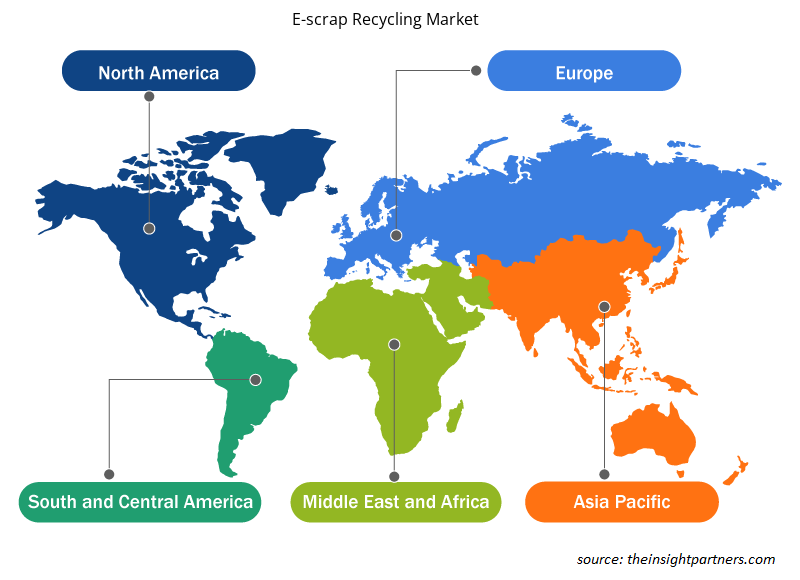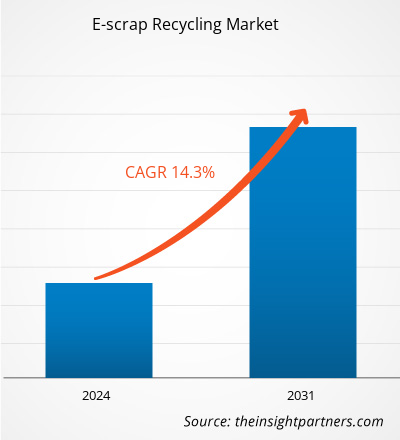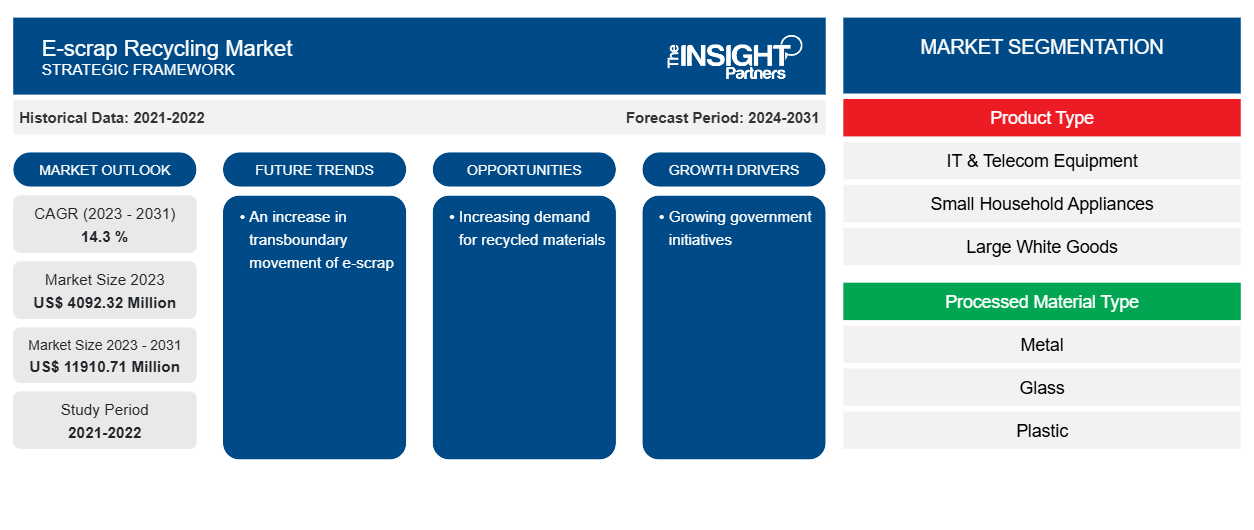Der Markt für das Recycling von Elektroschrott soll von 4092,32 Millionen US-Dollar im Jahr 2023 auf 11.910,71 Millionen US-Dollar im Jahr 2031 anwachsen. Der Markt soll zwischen 2023 und 2031 eine durchschnittliche jährliche Wachstumsrate von 14,3 % verzeichnen. Ein Anstieg des grenzüberschreitenden Transports von Elektroschrott dürfte ein wichtiger Trend auf dem Markt bleiben.
Marktanalyse für E-Schrott-Recycling
Hersteller von Haushaltsgeräten bieten auch neuere Modelle an, um Kunden anzulocken. Die Markteinführung neuer Produkte geht der Verschrottung der vorhandenen Haushaltsgeräte voraus , was den Akteuren auf dem Markt für Elektroschrottrecycling zugutekommt. Dies verändert die Elektroschrottrecyclingbranche erneut. Da der technologische Fortschritt weltweit rasant voranschreitet, müssen die Hersteller außerdem Verbraucherelektronik oder Haushaltsgeräte mit begrenzter Lebensdauer herstellen. Dies hilft den Herstellern, ihre Technologien im Laufe der Zeit zu verbessern, was zu einer Verringerung der Anzahl elektronischer Schrottplätze führt, was letztendlich den Markt für Elektroschrottrecycling antreibt.
Marktübersicht zum Recycling von Elektroschrott
Beim Recycling von Elektroschrott werden wertvolle Gegenstände gewonnen, indem der Elektroschrott in kleine Stücke zerlegt wird, die in einem neuen elektronischen Gerät recycelt werden können. Das Recycling von Elektroschrott hat viele Vorteile, darunter den Schutz der Umwelt und der menschlichen Gesundheit. Die meisten Materialien, aus denen Smartphones und Computer bestehen, bestehen aus nicht erneuerbaren Mineralien. Durch das Recycling dieser Materialien kann verhindert werden, dass die Versorgung mit Konsumgütern, die im Leben unverzichtbar sind, unterbrochen wird, bis Ersatz gefunden wird.
Passen Sie diesen Bericht Ihren Anforderungen an
Sie erhalten kostenlos individuelle Anpassungen an jedem Bericht, einschließlich Teilen dieses Berichts oder einer Analyse auf Länderebene, eines Excel-Datenpakets sowie tolle Angebote und Rabatte für Start-ups und Universitäten.
- Holen Sie sich die wichtigsten Markttrends aus diesem Bericht.Dieses KOSTENLOSE Beispiel umfasst eine Datenanalyse von Markttrends bis hin zu Schätzungen und Prognosen.
Treiber und Chancen auf dem Markt für E-Schrott-Recycling
Zunehmende Regierungsinitiativen
Die Regierungen verschiedener Länder ergreifen Initiativen zum Recycling von Elektroschrott. Die Regierung hat eine Reihe von Schritten unternommen, um den Recyclingsektor für Elektroschrott in den verschiedenen Ländern zu formalisieren. Die E-Waste (Management)-Regeln sehen eine obligatorische Genehmigung der Abbruch- und Recyclingeinheiten durch die beteiligten State Pollution Control Boards (SPCBs)/Pollution Control Committees (PCCs) vor. Das CPCB hat Richtlinien für die Verarbeitung von Elektroschrott herausgegeben. Das CPCB und die SPCBs haben die Einheiten beobachtet und mit Hilfe des Ministeriums für Elektronik und Informationstechnologie wurden die erforderlichen Maßnahmen ergriffen, um die Recyclingbranche zu verbessern und zu modernisieren. Daher treiben die wachsenden Regierungsinitiativen den Markt für das Recycling von Elektroschrott an.
Steigende Nachfrage nach recycelten Materialien
Verbraucher sind sehr zufrieden mit Produkten aus recycelten Materialien, die auch am Ende ihrer Lebensdauer ökologisch sind. In einer Umfrage unter einem Unternehmen ging eine große Mehrheit davon aus, dass Produkte aus recycelten Materialien denen aus Neumaterialien überlegen sind. Verbraucher weltweit sind zunehmend besorgt über Verpackungsmüll und die Freisetzung in die Umwelt, und die Regierungen haben begonnen, auf die öffentliche Meinung mit energischen Maßnahmen in beschleunigtem Zeitrahmen zu reagieren, sodass die Nachfrage nach recycelten Materialien steigt, was weitere Marktchancen schafft.
Segmentierungsanalyse des Marktberichts zum Recycling von Elektroschrott
Wichtige Segmente, die zur Ableitung der Marktanalyse zum Recycling von Elektroschrott beigetragen haben, sind Komponente, Protokoll und Anwendung.
- Basierend auf dem Produkttyp ist der Markt für das Recycling von Elektroschrott in IT- und Telekommunikationsgeräte, kleine Haushaltsgeräte, große Haushaltsgeräte, Unterhaltungselektronik und Sonstiges unterteilt. Das Segment IT- und Telekommunikationsgeräte hatte im Jahr 2023 einen größeren Marktanteil.
- Nach verarbeitetem Materialtyp ist der Markt in Metall, Glas, Kunststoff und Sonstiges segmentiert.
Marktanteilsanalyse für E-Schrott-Recycling nach geografischer Lage
Der geografische Umfang des Marktberichts zum Recycling von Elektroschrott ist hauptsächlich in fünf Regionen unterteilt: Nordamerika, Asien-Pazifik, Europa, Naher Osten und Afrika sowie Süd- und Mittelamerika.
Der APAC-Markt dominiert den E-Schrott-Recyclingmarkt. Verschiedene Faktoren treiben den E-Schrott-Recyclingmarkt im APAC-Raum an, wie wachsende Regierungsinitiativen, steigende Nachfrage nach recycelten Materialien und mehr. Daher wächst der Markt in der Region erheblich.
Regionale Einblicke in den Markt für E-Schrott-Recycling
Die regionalen Trends und Faktoren, die den Markt für E-Schrott-Recycling im Prognosezeitraum beeinflussen, wurden von den Analysten von Insight Partners ausführlich erläutert. In diesem Abschnitt werden auch die Marktsegmente und die Geografie des E-Schrott-Recyclings in Nordamerika, Europa, im asiatisch-pazifischen Raum, im Nahen Osten und Afrika sowie in Süd- und Mittelamerika erörtert.

- Erhalten Sie regionale Daten zum Markt für Elektroschrott-Recycling
Umfang des Marktberichts zum Recycling von Elektroschrott
| Berichtsattribut | Details |
|---|---|
| Marktgröße im Jahr 2023 | 4092,32 Millionen US-Dollar |
| Marktgröße bis 2031 | 11910,71 Millionen US-Dollar |
| Globale CAGR (2023 - 2031) | 14,3 % |
| Historische Daten | 2021-2022 |
| Prognosezeitraum | 2024–2031 |
| Abgedeckte Segmente | Nach Produkttyp
|
| Abgedeckte Regionen und Länder | Nordamerika
|
| Marktführer und wichtige Unternehmensprofile |
|
Marktteilnehmerdichte: Der Einfluss auf die Geschäftsdynamik
Der Markt für das Recycling von Elektroschrott wächst rasant. Dies wird durch die steigende Nachfrage der Endverbraucher aufgrund von Faktoren wie sich entwickelnden Verbraucherpräferenzen, technologischen Fortschritten und einem größeren Bewusstsein für die Vorteile des Produkts vorangetrieben. Mit der steigenden Nachfrage erweitern Unternehmen ihr Angebot, entwickeln Innovationen, um die Bedürfnisse der Verbraucher zu erfüllen, und nutzen neue Trends, was das Marktwachstum weiter ankurbelt.
Die Marktteilnehmerdichte bezieht sich auf die Verteilung von Firmen oder Unternehmen, die in einem bestimmten Markt oder einer bestimmten Branche tätig sind. Sie gibt an, wie viele Wettbewerber (Marktteilnehmer) in einem bestimmten Marktraum im Verhältnis zu seiner Größe oder seinem gesamten Marktwert präsent sind.
Die wichtigsten auf dem Markt für Elektroschrott-Recycling tätigen Unternehmen sind:
- DOWA HOLDINGS CO. LTD
- Ecoreco Ltd.
- Electronic Recyclers International Inc
- Enviro-Hub Holdings Ltd
- JX Nippon Mining & Metals Corporation
- Sims Metal Management Ltd
Haftungsausschluss : Die oben aufgeführten Unternehmen sind nicht in einer bestimmten Reihenfolge aufgeführt.

- Überblick über die wichtigsten Akteure auf dem Markt für Elektroschrott-Recycling
Neuigkeiten und aktuelle Entwicklungen zum Markt für E-Schrott-Recycling
Der Markt für E-Schrott-Recycling wird durch die Erhebung qualitativer und quantitativer Daten aus Primär- und Sekundärforschung bewertet, die wichtige Unternehmensveröffentlichungen, Verbandsdaten und Datenbanken umfasst. Nachfolgend sind einige der Entwicklungen auf dem Markt für E-Schrott-Recycling aufgeführt:
- Die Regierung wird in Kürze eine Online-Plattform einrichten, um den Handel mit Zertifikaten der erweiterten Herstellerverantwortung (Extended Producer Responsibility, EPR) zu erleichtern. Dieser Schritt wird dem Land helfen, die wachsende Plage des Elektroschrotts, wie etwa nicht mehr funktionierende Mobiltelefone und Laptops, zu bekämpfen. (Quelle: Extended Producer Responsibility (EPR), Pressemitteilung, März 2024.)
- Große Elektronikhersteller haben sich diese Woche mit der Consumer Technology Association zusammengeschlossen, um die Consumer Technology Circularity Initiative zu gründen, deren Ziel darin besteht, die Verarbeitung von Elektroschrott zu fördern, Reparatur und Wiederverwendung zu verbessern und mehr recycelte Materialien in Produkte einzubauen. (Quelle: Consumer Technology Association, Pressemitteilung, Januar 2024)
Marktbericht zum Recycling von Elektroschrott – Umfang und Ergebnisse
Der Bericht „Marktgröße und Prognose für das Recycling von Elektroschrott (2021–2031)“ bietet eine detaillierte Analyse des Marktes, die die folgenden Bereiche abdeckt:
- Marktgröße und Prognose für E-Schrott-Recycling auf globaler, regionaler und Länderebene für alle wichtigen Marktsegmente, die im Rahmen des Berichts abgedeckt sind
- Markttrends und Marktdynamiken für das Recycling von Elektroschrott wie Treiber, Hemmnisse und wichtige Chancen
- Detaillierte PEST/Porters Five Forces- und SWOT-Analyse
- Marktanalyse zum Recycling von Elektroschrott mit Blick auf wichtige Markttrends, globale und regionale Rahmenbedingungen, wichtige Akteure, Vorschriften und aktuelle Marktentwicklungen
- Branchenlandschaft und Wettbewerbsanalyse, einschließlich Marktkonzentration, Heatmap-Analyse, prominenten Akteuren und aktuellen Entwicklungen auf dem Markt für E-Schrott-Recycling
- Detaillierte Firmenprofile
- Historische Analyse (2 Jahre), Basisjahr, Prognose (7 Jahre) mit CAGR
- PEST- und SWOT-Analyse
- Marktgröße Wert/Volumen – Global, Regional, Land
- Branchen- und Wettbewerbslandschaft
- Excel-Datensatz
Aktuelle Berichte
Erfahrungsberichte
Grund zum Kauf
- Fundierte Entscheidungsfindung
- Marktdynamik verstehen
- Wettbewerbsanalyse
- Kundeneinblicke
- Marktprognosen
- Risikominimierung
- Strategische Planung
- Investitionsbegründung
- Identifizierung neuer Märkte
- Verbesserung von Marketingstrategien
- Steigerung der Betriebseffizienz
- Anpassung an regulatorische Trends





















 Kostenlose Probe anfordern für - Markt für Elektroschrott-Recycling
Kostenlose Probe anfordern für - Markt für Elektroschrott-Recycling